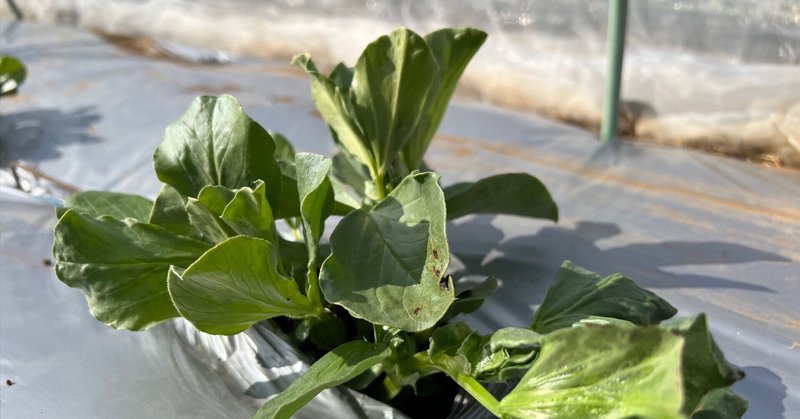
【Koyomi】February 13, 2024
Life with a vegetable Garden|Fava bean
菜園のある暮らし|ソラマメ
Removing Aphids
As we get busy with soil preparation and other tasks after the beginning of spring, we start to remove aphids that are lurking on the leaves of fava beans and other plants. Of course, we use nets for cold and pest protection, and also apply silver mulch as shown in the photos, but that doesn't seem to matter. We've found aphids again this year! I've tried various methods of aphid control, but personally, I prefer the method of diligently brushing them off with a soft brush or broom.
アブラムシの除去
立春を過ぎると土作りなど忙しくなる中、ソラマメの葉などに潜んでいるアブラムシの除去を始めます。もちろん、防寒や防虫の為にネット、また写真のようにシルバーマルチをかけたりしていますがそんなことは関係ありません。今年もアブラムシ発見です!アブラムシの防除をいろいろ試しましたが、個人的には先の柔らかい筆やハケでこまめに払い落としていく方法が気に入っています。

The Origin of the Name 'Aphid'
Aphids are small insects familiar to many of us, but the origin of their name holds an unexpected history. In Japanese, aphids are written as "油虫" (oil insect), and this name dates back to an interesting etymology from the Edo period. During that era, children would catch a few aphids parasitizing bush clovers, crush them by hand, and apply the liquid to their hair as part of a unique play activity. The purpose of this game was to make their hair shiny by applying the liquid obtained from the crushed aphids. It seems that the name "oil insect" was born from this custom. This origin presents a fascinating example of how the creature of aphids has been integrated into human culture and life. Aphids are known for sucking the sap from plants and are often considered pests in agriculture. However, considering how they have been blended into human life since ancient times, our view of them might change slightly. It reminds us that aphids are not just pests but have had a long-standing relationship with humans.
アブラムシの名前の由来
アブラムシは、私たちの身近な小さな昆虫ですが、その名前には意外な歴史が隠されています。日本語で「油虫」と書かれるアブラムシの名前は、なんと江戸時代にさかのぼる興味深い語源を持っています。
その時代、子供たちはハギに寄生するアブラムシを数匹捕まえ、手で潰して頭髪に塗るという珍しい遊びをしていました。この遊びの目的は、潰したアブラムシから出る液体を髪に塗ることで、髪をテカテカに光らせることにありました。この風習から、「油虫」という名前が生まれたようです。この由来は、アブラムシという生き物が私たち人間の文化や生活の一部としてどのように組み込まれてきたかを示す興味深い例です。
アブラムシ自体は、植物の汁を吸うことで知られており、農業においては害虫と見なされることが多いです。しかし、このように古くから人々の生活の中に溶け込んでいたことを考えると、彼らに対する見方が少し変わるかもしれません。ただの害虫ではなく、人間との長い関係を持っていたことを思い出させてくれます。
Revising This Year's Planting Plan: Soil pH and New Challenges
Under normal circumstances, by this time of the year, the planting plan would already be finalized. However, this year, we have decided to review and make some changes to our plan for mainly two reasons:
Adjustment of Soil pH Levels
With the decision to transition to the neighboring field this year, it became necessary to assess the condition of the new land. Upon checking the soil acidity, we found the pH levels to be around 7.0 to 7.5. While a pH level of approximately 6.0 is considered ideal for planting potatoes, the current state of the soil does not meet this criterion. The cause of this issue is still unclear, but we are exploring methods to adjust the pH to an appropriate level.Introduction of New Crops
Inspired by a recent soba noodle-making experience, we are considering introducing new vegetables that can be enjoyed with soba. We plan to try a new combination of flavors by planting corn, which is perfect for tempura, in March, and a slightly spicy variety of radish, "Spicy Radish," in the spring.今年の作付け計画の見直し:土壌のpHと新たな挑戦
今年の作付け計画の見直し:土壌のpHと新たな挑戦
通常であれば、この時期には作付け計画をすでに締めくくっているものですが、今年はいくつかの変更があり、計画の見直しを行うことにしました。その理由は主に以下の二つです。
1. 土壌のpH値の調整
今年から隣の畑への移行を決めたことで、新たな土地の状態を確認する必要がありました。土壌の酸度をチェックしたところ、pH値が7.0から7.5程度となっていました。ジャガイモの植え付けにはpH6.0程度が適しているとされていますが、現在の土壌状態ではこれを満たしていません。この問題の原因はまだ明確ではありませんが、適正なpH値への調整方法を模索しています。
2. 新たな作物の導入
また、最近参加した蕎麦打ち体験からインスピレーションを得て、蕎麦と共に楽しむことができる新しい野菜の導入を検討しています。かき揚げにぴったりなトウモロコシを3月に、そして少し辛味のある「辛味大根」を春に蒔くことで、新しい味わいの組み合わせを試してみる予定です。
この記事が気に入ったらサポートをしてみませんか?
